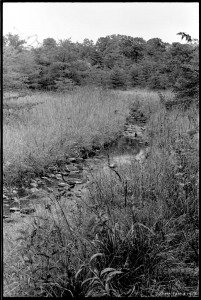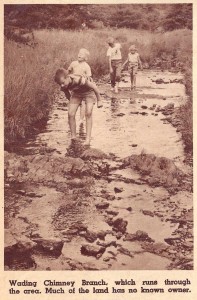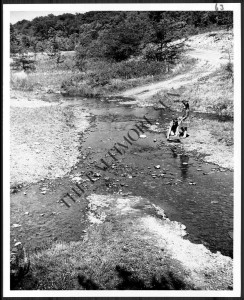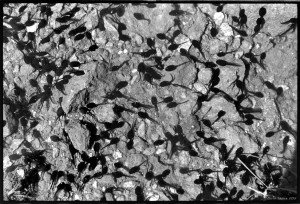Click photos to enlarge.
As a kid, my favorite thing about Soldiers Delight was playing in the streams. They were very different from all other streams I knew, which were muddy. In Baltimore County walking in a stream generally meant walking in mud. The water in Soldiers Delight streams was clear, and the stream bottoms were mostly stoney. The stream banks were also grassy and sunny. Streams elsewhere could be sunny, but even managed streams through pastures or parks were often lined with a thicket of woody plants. At Soldiers Delight long stretches of streams were lined only with tall grasses and wildflowers. Plus there were minnows and frogs and snakes. These were great streams.

I assume they are still like that. Soldiers Delight is a local high spot, and the radiating watersheds include mostly undeveloped serpentine. I think serpentine weathers differently from other rocks, and may form less clay and silt. There is certainly less fine soil on the barren slopes that could wash into the streams, but maybe it already washed away. So I’m not sure why the streams were so clear and mud-free. I assume the stream banks have become less sunny as Virginia pine encroaches, but maybe there has been some tree removal to encourage fringed gentians and the streams are still sunny.

Another thing that could have influenced the nature of Soldiers Delight’s streams is buddles. Buddles are ore processing contraptions that work like sluices to wash lighter material away from the heavier metal or ore. The sites of four 19th century buddles in Soldiers Delight are well documented, and we even know the quantity and quality of “chrome sand” some of them produced for certain periods.

I have never seen the buddle sites at Soldiers Delight, and I don’t know if anything is still visible. I don’t know it they were round or rectangular. The stream bank sediments were carried to the buddle and dumped at the high spot (which was the center of the round ones) and washed so the waste material went downhill. After the first separation, some of it could be moved to the high place and washed again.

Buddle operations in Soldiers Delight began before Issac Tyson’s bedrock chromite mining started in the 1820s, was intermittent throughout the 19th century, and continued until a few years after bedrock mining stopped in 1918.

The buddles were built near placer deposits where the chromium rich sands had been deposited along streams. Water was needed for their operation, so they had to be located as far downstream as possible (where the stream had more flow) but without leaving the serpentine outcrop (so the floodplain sediments were not diluted with non-serpentine material). But placer material could be brought to the buddle, and long stretches of streams were probably scraped clean as wagon loads were hauled by horses down to the buddles. I have never heard that dams were built to store water for processing, but it seems likely that this would have happened, especially directly upstream from the buddles. The typical round buddles had a rotating arm which swept the sediments to aid the separation, and this could be powered by a water wheel which would have required a dammed reservoir.

So the beautiful, clean streams at Soldiers Delight probably looked the way they did when I was a kid largely because they had been dramatically altered during the previous century. The lack of fine sediments and woody plants may be a direct result of their removal several decades earlier.

With that much stream bank disturbance throughout the 19th century, it’s surprising that a fragile plant like the fringed gentian, which is restricted to sunny, grassy, stream banks, would have survived. So it is possible that it did not survive that disturbance because it wasn’t even there then.

It may be that the fringed gentian established at Soldiers Delight only after the mining disturbance stopped in the early 20th century. It might just be another recent invader, albeit a rare and beautiful one. It somehow tolerates the high Mg:Ca ratio in the soil and enjoys freedom from competition from all the plants that can’t. But as succession proceeds, the gentian is being pushed out. It had a good run in the mid 20th century. And so did we.

.
Chromite and Other Mineral Deposits in Serpentine Rocks Of the Piedmont Upland Maryland, Pennsylvania And Delaware By NANCY C. PEARRE and ALLEN V. HEYL, JR. 1960
.
Plates from above reference.
